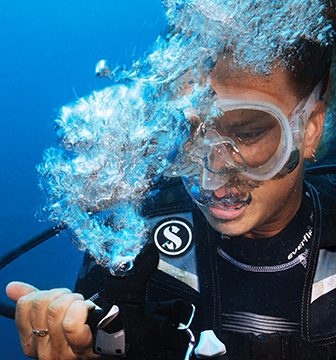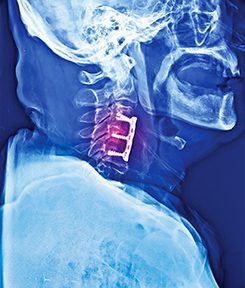DAN® medical information specialists and researchers answer your dive medicine questions.

I have developed Bell’s palsy. Due to its internal effects, are there any reasons I should not dive? I understand the risks of its external effects — such as not being able to blink in a mask-clearing situation and not having full control of the regulator in my mouth — but could diving cause anything to happen internally that would worsen the condition?
There is no evidence suggesting that diving worsens the effects of Bell’s palsy, and no studies show adverse effects. The main concern is that facial droop, eye twitching or inability to close your eye, facial numbness or paralysis, drooling, pain around your jaw or behind the ear, and a headache could all accompany Bell’s palsy. These symptoms compromise dive safety by not allowing you to securely close your mouth around a regulator, increasing the risk of aspirating seawater, and causing eye irritation. Anything that diverts your attention from diving is a safety risk. Signs and symptoms of Bell’s palsy can also mimic a stroke or decompression sickness, making it very difficult for a physician to make an accurate diagnosis should something happen while diving.
One consideration is to employ conservative behaviors such as diving well within your no-decompression limit, diving on enriched air nitrox while setting your computer to air, lengthening your safety stops, and limiting yourself to one or two dives per day with a rest day between dive days. These approaches can be beneficial for lowering your decompression stress.
Provided all your symptoms are resolved, diving should not be an issue. If you are experiencing any continued symptoms, regardless of how slight, you should postpone diving until you are completely asymptomatic.
— Anne Strysniewicz, AEMT, DMT

I dive using nitrox and am wondering if I can safely use Sudafed and Claritin while diving.
There are two significant issues with using Sudafed (pseudoephedrine) while diving. Research shows a theoretical risk of oxygen toxicity with Sudafed while diving with higher partial pressures of oxygen. Pseudoephedrine was not tested specifically, but it is a sympathomimetic — a drug that produces effects similar to those the sympathetic nervous system produces — so we might infer from other drugs in that category that it has a similar effect. In addition, our current understanding of the mechanisms that cause oxygen convulsions would predict that sympathomimetic drugs might enhance susceptibility to oxygen convulsions.
Given the findings from that study, we can say there may be an increased risk of oxygen toxicity, but this is not likely under recreational diving limitations.
The other issue with Sudafed is that it has a relatively short half-life, meaning that its effects wear off quickly, and your congestion can return abruptly as the drug wears off. This rapid shift can create the conditions for a reverse squeeze. The difficulty is that it is hard to equalize if the issues occur during your ascent. If your congestion returns during a dive, it is possible that your return to the surface may cause a significant barotrauma injury.
Sudafed is a decongestant, whereas Claritin (loratadine) is an antihistamine and may not provide the same equalization benefits. Claritin-D is a combination of the two drugs and may provide equalization benefits in a longer-lasting preparation with a decreased tendency to wear off. You may want to talk to your doctor about alternative options for keeping congestion in check. If you always require decongestants for problems equalizing, you may want to consult with an ear, nose, and throat specialist.
— Ben Strelnick, NREMT, W-EMT
While on a cruise, I booked a dive excursion through one of the recommended vendors. As we finished the dive, the cruise ship was leaving port without me. We had just completed a dive to a maximum depth of 55 feet for 50 minutes on air, a 45-minute surface interval, and a second dive to a maximum depth of 43 feet for 50 minutes. The vendor and cruise line took responsibility for the mishap and booked me on a flight to meet the ship at the next port. Four hours elapsed from the end of my dives to my flight departure. I did not have any pain or symptoms during the flight, and I still feel fine. After hearing my story, a local dive instructor told me I should not have flown without a longer surface interval. Should I be worried about decompression sickness (DCS)?
DAN has well-established recommendations for safe flying after diving based on our 2002 Flying After Recreational Diving Workshop. Based on your dive profiles, the minimum recommended surface interval before flying should have been 18 hours.
Dive tables and computer algorithms are based on theoretical models and designed for the masses. It is practically impossible to create a model to determine an individual’s risk and the factors that would make someone susceptible to DCS. Many things determine a person’s decompression stress. The shallow dives and short bottom times may have helped in your situation, but nothing guarantees a repeat outcome under the same circumstances in the future.
Upon surfacing, the nitrogen from your dives begins to leave your body tissues. Most inert gas is eliminated 24 hours after the dive, which is one of the reasons you can fly 18 hours after a dive activity. It is rare for someone to experience DCS more than 24 hours after diving.
Since you have flown home without experiencing symptoms in flight, and you are still symptom-free a few days later, it is reasonably safe to say you will not experience DCS.
— Robert Soncini, NR-P, DMT

I am scheduled to undergo cervical fusion and discectomy. When can I dive again after surgery?
There are several considerations to discuss with your surgeon. After surgery, the minimum benchmarks to meet are to be released by your physician for full and unrestricted activity, including contact sports, and then add an additional convalescent period equal to at least half of your healing time. If your doctor releases you for unrestricted activity after eight weeks, for example, your total waiting period would be 12 weeks. That extra time will help you regain the physical fitness and aerobic capacity you lose from atrophy during your recuperation. Once you’re back into a regular exercise routine after the waiting period, you can discuss a return to diving with your doctor.
Diving typically requires you to perform certain physical demands that you may want to discuss with your orthopedic surgeon. You need to be able to carry weights around and walk while fully geared. Your dive preparation might require significant weight on your shoulders. Boarding a boat after diving means you need to climb a ladder fully geared. Shore dives could pose an additional risk, with the difficulty of navigating surge and uneven surfaces such as river rocks and iron shore. If you are in a leadership position, you’ll also need to be ready to help others with their gear and keep them safe by whatever means necessary, so your physician will need to feel comfortable that you will be up to the task.
There is an increased risk of spinal DCS in people with previous spinal injuries, including surgery. Adding into your diving as many conservative behaviors as possible will help mitigate this risk, but nothing will eliminate it. Behaviors such as diving nitrox while using air tables, limiting the number of dives per day, limiting the number of consecutive dive days, and increasing safety stop and surface interval times are easy changes.
— Lana P. Sorrell, MBA, EMT, DMT

I was recently diagnosed with benign paroxysmal positional vertigo (BPPV). I’m seeing a physical therapist to resolve the vertigo and move the otoliths (crystals) out of my inner-ear canals. If my symptoms are resolved, and I am not experiencing vertigo, do you know of any pressure-related issues concerning BPPV that I should be aware of while diving?
with BPPV, diving is not recommended for anyone with this condition. Certain head and neck movements while on deck, entering and leaving the water, and during the dive may provoke another episode and result in serious injury. It’s a good idea to consider the risk of incapacitation from a sudden onset of vertigo, the danger of which increases exponentially in the underwater environment.
Additionally, the symptoms of BPPV can resemble those seen in serious medical conditions such as DCS and lead to an inappropriate or incorrect diagnosis of an underlying condition, which may result in improper treatment. BPPV symptoms may be debilitating or incapacitating, so a diver needs to consider the risks to themselves and others around them should they require assistance.
Before diving, a physician trained in dive medicine should evaluate your condition and carefully explain the risks.
— Anne Strysniewicz, AEMT, DMT
© Alert Diver — Q2 2022